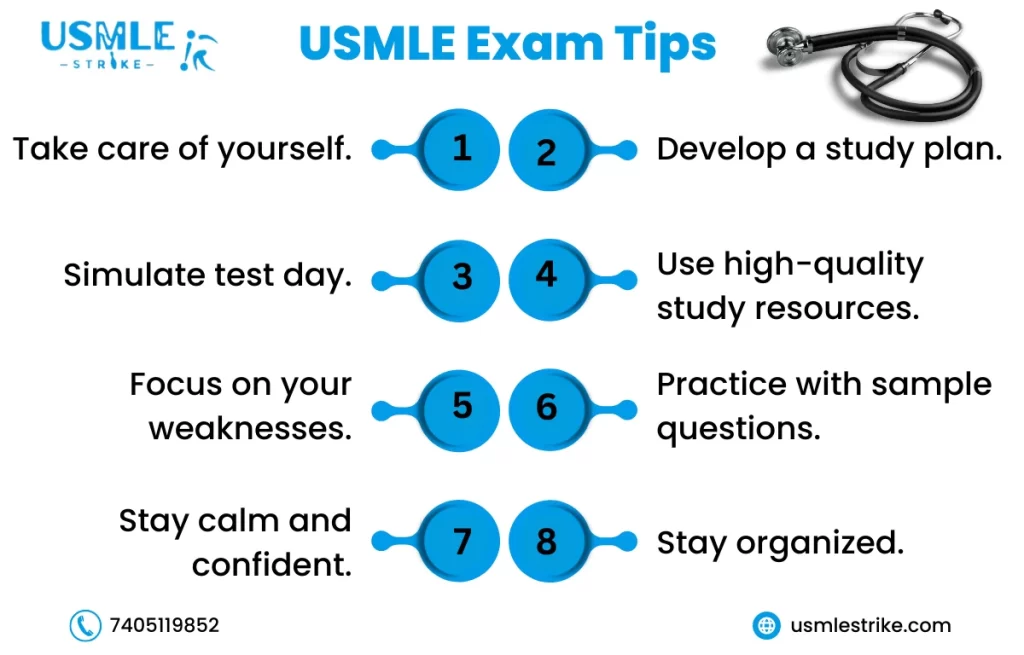The United States Medical Licensing Examination (USMLE) is a standardized exam that is required for medical licensure in the United States. The exam assesses the knowledge, skills, and abilities of medical students and graduates, and is a critical step in the process of becoming a licensed medical practitioner.
In this blog, we will provide the USMLE exam details including its structure, content, and tips for preparing and succeeding.
Content outlines for all Step exams are updated by the USMLE program
The purpose of this update is to ensure that the USMLE remains clinically relevant
A diverse national faculty of medicine, drawn from medical schools, state licensing boards, and clinical practice settings from every region of the United States, reviews and modifies the content on the USMLE as needed to reflect evolving practice guidelines.
The USMLE exams are based on two classification schemes: an integrated content outline that organizes content by organ systems, and a physician tasks and competencies outline. These schemes help to ensure that the exams cover all necessary topics and skills. The latest modification to the content outline aims to better incorporate foundational science principles into individual organ systems while maintaining the proportion of foundational science covered within the exams. This ensures that these principles are tested in a clinically relevant manner. The text has been edited to ensure short and straightforward sentences, active voice, logical structure, verb phrases, standard sentence structure, grammatical correctness, simple vocabulary, and accessible language. No changes in content have been made.

USMLE Exam Structure
Part 1: USMLE Step 1
The USMLE Step 1 is a computer-based exam that assesses the basic science knowledge of medical students and graduates. The exam is composed of 280 multiple-choice questions and is divided into seven 60-minute blocks and takes a duration of 8 hours to complete it.
Syllabus: This covers a wide range of topics, including anatomy, physiology, biochemistry, pharmacology, microbiology, and pathology. It is crucial to prepare after knowing the USMLE exam details thoroughly as it determines the candidate’s eligibility to continue with the licensure process.
Part 2: USMLE Step 2
USMLE Step 2 CK
The USMLE Step 2 CK is a computer-based exam that assesses the clinical knowledge and skills of medical students and graduates. The exam is composed of 318 multiple-choice questions and is divided into eight 60-minute blocks with a total of 9 hours allotted for it.
Syllabus: This exam covers a wide range of topics, including internal medicine, surgery, paediatrics, obstetrics, and gynaecology. It is essential to know the USMLE exam details and have a strong understanding of these topics to pass the exam successfully.
Part 3: USMLE Step 3
The USMLE Step 3 is the last stage or the final exam in the licensure process. The exam assesses the candidate’s ability to apply medical knowledge and skills to the care of patients. The exam is divided into two parts: Foundations of Independent Practice (FIP) and Advanced Clinical Medicine (ACM).
The United States Medical Licensing Examination (USMLE) is a three-step examination required for medical licensure in the United States. Each step assesses a different aspect of a physician’s ability to apply knowledge, concepts, and principles essential for patient care. Below is a detailed overview of the USMLE exam pattern:
| Step | Purpose | Format | Duration | Number of Questions | Question Distribution |
|---|---|---|---|---|---|
| Step 1 | Assesses understanding and ability to apply basic science concepts to medical practice. | Computer-based test divided into seven 60-minute blocks. | 8 hours (including breaks and tutorial). | Approximately 280 multiple-choice questions. | Each block contains up to 40 questions. |
| Step 2 Clinical Knowledge (CK) | Evaluates medical knowledge and understanding of clinical science necessary for patient care under supervision. | Computer-based test divided into eight 60-minute blocks. | 9 hours (including breaks and tutorial). | Approximately 318 multiple-choice questions. | Each block contains up to 40 questions. |
| Step 3 | Assesses ability to apply medical knowledge and understanding of biomedical and clinical science essential for unsupervised practice. | Two-day computer-based test: Day 1: Foundations of Independent Practice (FIP) – Six 60-minute blocks. Day 2: Advanced Clinical Medicine (ACM) – Six 45-minute blocks and 13 computer-based case simulations. | Day 1: Approximately 7 hours. Day 2: Approximately 9 hours. | Day 1: Approximately 232 multiple-choice questions. Day 2: Approximately 180 multiple-choice questions and 13 case simulations. | Day 1: Each block contains 38-39 questions. Day 2: Each block contains 30 questions; each case simulation is allotted 10 or 20 minutes of real-time. |
Note: As of January 2022, Step 1 scoring has transitioned to a pass/fail system.
Understanding the structure and content of each USMLE step is crucial for effective preparation and successful completion of the examination process.
Foundations of Independent Practice (FIP)
The FIP exam assesses the candidate’s ability to manage common and complex medical problems in an outpatient setting. You should know the USMLE exam details for this as well because it is composed of 233 multiple-choice questions and is divided into six 60-minute blocks with a duration of 7 hours allotted for it.
Advanced Clinical Medicine (ACM)
The ACM exam assesses the candidate’s ability to manage common and complex medical problems in an inpatient setting. The exam is composed of 180 multiple-choice questions and is divided into six 45-minute blocks with a duration of 9 hours allotted for it.
Preparation for the USMLE Exam
Preparing for the USMLE exams after understanding the USMLE exam details requires a significant investment of time, effort, and resources. However, with the right approach and mindset, you can succeed in these exams and take a step closer to becoming a licensed physician in the United States.
Here are some tips for preparing for the United States Medical Licensing Examination:
- Start Early: Familiarize yourself with the exam format and content, and create a study schedule that allows you to cover all the topics thoroughly.
- Use Reliable Study Resources: Choose resources that are reliable, updated, and aligned with the exam content.
- Practice Regularly: Use practice questions and exams to test your knowledge and identify areas that need more work.
- Collaborate with Peers: Form study groups, discuss difficult concepts, and quiz each other on the exam content.
- Take Care of Your Health: Exercise regularly, get enough sleep, eat a balanced diet, and take breaks to avoid burnout.
USMLE Exam Details: Retakes, Time Limits & Number of Attempts
USMLE applicants are allowed a maximum of four attempts for each Step, including attempts for Step 2 CS. These three initial attempts must occur within a 12-month period, and the fourth attempt should be at least 12 months after the first try. Moreover, there should be a minimum six-month gap after the last examination attempt. Once a Step or Step Component is passed, retakes are not permitted, unless necessary to comply with the prescribed time limits set by the U.S. physician licensing authority. All Steps must be completed within the specified deadline.
Conclusion
To conclude, the USMLE exams are a critical step in the journey of becoming a licensed physician in the United States. With the right approach and mindset, you can succeed in this medical exam and take a step closer to achieving your career goals.





